Instructions for our FORMS
To teach a client the SEAM tools, you must first learn to use them yourself. It develops your skills in listening and note-taking. Its a good idea to save the report template for your Client Report to your computer. The Report Template has 23 Steps to follow, and has examples in it from student projects.
Each team prints there team scoring form for the entire class to fill out for their event
6 MANAGEMENT TOOL in WORD YOU NEED to download and begin using:
- PNAC TOOL form
- TIME MANAGEMENT TOOL form
- PAP TOOL form
- IESP TOOL form
- COMPETENCY GRID TOOL form
- PILOTING LOGBOOK WEEKLY UPDATE
Begin by memorizing the 4-Leaf Clover Themes for your Interviews.
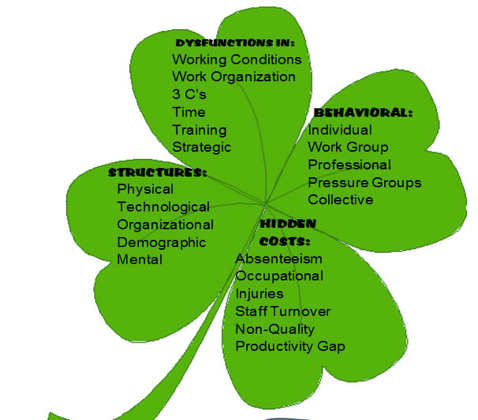
Then understand that you are consulting in-order-to find the Hidden Costs of the Dysfunctions, but BENEATH all that are the 6 ROOT CAUSES of FINANCIAL RESULTS, that I call the 'stem-roots.'

Then memorize the above 6 Financial Consequences of the way the business is organized now.
Then, you can FOLLOW the 23 STEPS to SUCCESS
To do SEAM Consulting, you will work through 23 steps that take you one step at a time, through the A-B-C Spiral Axes. Start at the center at the Clover Leaf, do Diagnosis step, then Time Management Tool, then see if there are Changes in Technology to be made. Then keep steping through the model.
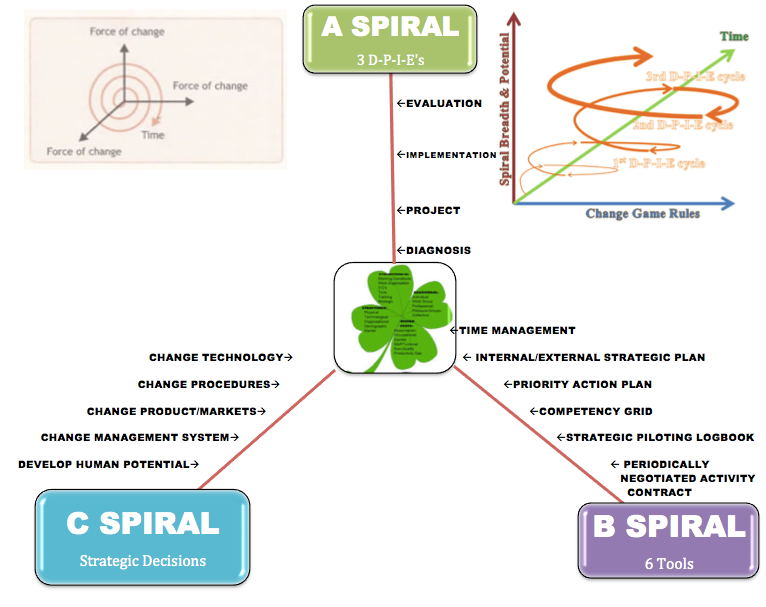
23 Consulting Steps to SUCCESS!
Step 1 - Diagnostic (A-spiral: Diagnostic, Project Plan, Implementation, & Evaluation of Results) DONE WITH INTERVIEW
Step 2 Time Management Tool (Time Management) Spiral B’s first tool
Step 3 - Direction (C-spiral), which is also the 1st D-question (Directionality)
Step 4 - Project planning (A-spiral) done collaboratively with your client
Step 5 - Strategic Piloting Logbook tool (B spiral)
Step 6 - Change Procedures: Rules of the game - (C-spiral)
Step 7 - D2 - Datability-important datable moments in life story of business?
Step 8 - Mirror Effect meeting with client (A-spiral, part of 1st D-P-I-E cycle).
Step 9 - Implement Project in collaboration with your client (A-spiral)
Step 10 - Priority Action Plan tool (B-spiral)
Step 11 - Resource Deployment (C-spiral)
Step 12 - D3 and D4 (Q-Spiral: Durability and Disclosability of the ROOTS)
Step 13 - Evaluation (A-spiral) evaluate results of project using piloting Logbook indicators you have to date
Step 14 - Competency Grid (B-spiral)
Step 15 - D5, D6, D7 (Spiral: Destining, Deployment, & Dwelling)
Step 16 - Evaluation – (A-spiral) Evaluate Project # 2, Diagnostic, Project plan for 3rd project
Step 17 - I/E SP (Internal/External Strategic Plan) (B-spiral Tool 5)
Step 18 - More D's (Spiral: Deseverance & Drafts) 27
Step 19 - Complete the Evaluation (A-spiral) of the 3rd project27
Step 20 - PNAC (Periodically Negotiable Activity Contract) you set up day one
Step 21 - technological, product market, management systems, and develop human resources C-spiral
Step 22 - Last D's (Spiral: Dispersion & Detaching) processes no longer needed
Step 23 - Spiral-Updraft into FINANCIAL SUCCESS OF BUSINESS
Please download Report Template in WORD for FIlling out Final Report to your computer Begin with step 1, the Diagnostic Interview.
STEP ONE: THE INTERVIEW GUIDE for DIAGNOSIS of CLIENT
Please conduct diagnostic interview using the 4-Leaf Clover themes you memorized. Develop your own Interview Guide tool. List only most relevent themes and sub-themes to be discussed in your notebook pages. The Interview Guide Tool is used as part of your DIAGNOSIS in (D-P-I-E). Spend about 10 minutes on each of these themes.
SIX DOMAINS OF DYSFUNCTIONS CONSTITUTE FAMILIES OF THEMES & SOURCE OF IDEAS
1. What are the Working Conditions? Collect STORIES of every Workspace! Edward T. Hall (1959/1973:162) says"'space speaks" in a silent language of its conditions. People are territorial animals, and working conditions have spaces people care about deeply. Tour the Workspaces to get a holistic understanindg, then scrutinize the spaces, one by one, and draw a map of the local and global workspaces? How are workspaces Routinized & Standardized, or not? Stories of personal spaces and impersonal ones? Spaces for creativity & innovation? Just Chaotic? Poorly or intelligently organized working condition spaces? Your activities go on in each workspace? Resources in each? Degree of multi-tasking in workspaces? The spacetimemattering of the working conditions?
- What are the different kinds of workspaces? I.E. Local, Global, Shared, Private, Meetings, Conferences, Projects, Relaxation? Virtual workspaces?
- What is the density of each workspace? i.e. Do you share work spaces with others? Is it crowded? Desk-sharing? Collaborative spaces?
- How do you personalize your workspace?
- How do you react to each space? Are spaces equitably distributed? Or, larger spaces to people with more authority?
- How is space divided or not, between workspace and lifespace? Do you have workspace at home?
- Where are the creative spaces to work?
- Are workspaces centrally organized, with power at the top of the space?
- How are workingspaces currently dysfunctional? Stressful? Unappealing?
- What improvements would you like to see in workspace design?
- Is work time in linear-sequences of highly repetitive tasks?
- Is work organized in Natural Time Cycles? Following Seasons, Day & Night cycles, life cycles?
- Do the cycles of activities repeat exactly? Or, do cycles have different times, different elements, become SPIRALS?
- Is the spiral of time, upward and outward, with greater freedom? Or, is the spiral of time, downward and inward, sinking into the abyss?
- Is time centrally planned and managed by experts or planning bosses?
- What is the physical layout of the working conditions? Draw it.
- William James (1907: 97) says, “things tell a story.” What story do things here tell?
- What stories equipment tells?
- What stories the work processes tell?
- What stories the technologies tell?
- What is the spacetime location of resource consumption habits and practices?
QUESTIONS ABOUT SPACE OF WORKING CONDITIONS
QUESITONS ABOUT TIME OF WORKING CONDITIONS?
QUESTIONS ABOUT MATTERING?
2. What is your Work Organization? Bureaucratic? Mechanistic? Top-Down? Political? Flexible? Distribution of tasks? Promotion options? Lateral movement? Ensemble? What improvements are needed?
- Where do resources, materials, stuff come from and get sent to?
- How is the work organization connected to its supply chain?
- How balanced is the work organization with the Natural environment? How green?
3. 3C's (Communication, Coordination, Cooperation). Collect and catalogue stories of 3C's: How is the storytelling communication? What are the concrete problems that result when 3C-storyteling breaks down? What kind of formal contact exist (meetings, appointments, written communication, emails, screens)? What are existing circuits of informal contact? What improvements do you suggest? Current procedures that pose problems for delegation? Coordination? Scheduling?
4. Time Management? What is your typical work schedule at the moment? What constraints trouble your time management? Do you regularly schedule ahead of time? What concrete problems are encountered? What would your ideal time schedule be like?
5. Training? Record stories of training, OJT, special, who gets it and is it for areas that are strategic. What are the tasks for which you experience lack of training? What are your competencies that are not being used?
6. Strategic Implementation? For you what are the priority areas of general policy? Who decides what they will be? Would it be necessary to clarify certain objectives? If you notice a discrpancy between objectives and accomplishments, what do you do?
Each interview that lasts about an hour, should generate at least 10 pages of hand-written verbatim notes. Please record full sentences, put quotes around each verbatim statement. Do not put things in your words, use theirs. These notes and observations of hidden casts (untapped revenues) are basis for doing your Mirror-Effect meeting with your client. See pp. 136-138; pp. 144-145 in book, Mastering Hidden Costs and Socio-Economic Performance for more ideas on Interview Guide Tool. PURPOSE: To generate 100 pages of fieldnote quotes for your Mirror Effect Meeting. After each interview make MARGIN CODES (e.g. WC, WO, 3Cs, TM, Tng, SI) and highlight the possible quotes to use in Mirror-Effect (pp. 150-152).
Do Boje's 11 D Question Interview
11 D's |
Q to ask your client |
Directionality |
1. What is the directionality of the business processes; to what future are they headed? |
Datability |
2. What is the datability of the business process developments? |
Duration |
3. What is the duration of various business processes? |
Disclosability |
4. What is the disclosability of the future business processes revealed to you? |
Destining |
5. What is the destining of the processes unfolding in ways you can foretell? Follow up, in fore-caring, fore-structuring, fore-having, fore-conceiving. |
Deployment |
6. What is the deployment of business processes, in-order-to, for-the-sake-of? |
Dwelling |
7. What is the dwelling, in-place in the world of business processes? |
De-severance |
8. What is the de-severance (de-distancing) of space-time-mattering? |
Drafts |
9. What are the drafts, updraft, and downdraft, into tighter (down) orbits, or into more open outer orbits (up), and the turning points from one draft to another? |
Dispersion |
10. What is the dispersion of processes, too diverse, or consolidating them? |
Detaching |
11. What is the detaching from being drawn into they-ness, they-relations, they-self and finding a path of ownmost authentic potentiality-for-Being-a-whole-Self? |
Please record full sentences, take complete notes, do not make lists. If you cannot do this, then record and transcribe, but keep in mind, it takes 6 hours to transcribe 1 hour of interview. Therefore, do it right, and just take complete notes during interview to save many hours.
As part of the interview you do, you will be asking questions to get at Hidden Costs, Untapped Reveneue Potential, and FInancial Root-Stems
MIRROR-EFFECT MEETING
This is a meeting you schedule with your client BEFORE doing each of three D-P-I-E interventions. You will present verbatum quotes from interviews organized and ordered by the DYSFUNCTIONS and by the ROOT-STEPS.
ROOT-STEM (NON-PRODUCTIVITY): "The first dysfunction is described in the following question:
Seems like your biggest issue is a productivity gap?
At the office, everyone always comments on my organization, but at home my office is a mess."
TIME MANAGEMENT DYSFUNCTION: How much time do you feel that you waste to the mess?
"It’s more of an energy drain not to be neat and clean.
"I believe that time spent thinking about, or avoiding the mess could be better allocated to productive activities. The upfront cost of this process would be worth the long term addition to productivity."
RIGHT LEAF: Atrophied Behaviors: Individual- “Everyone works individually when they are performing their job duties. The DJ is busy playing the music, I am working the daily logs, and the manager is working the bills, and working with our clients.”
Do all four leaves, and all six root stems for A-level report.
There are additional examples in the report template.
Download Report Template in WORD
You also present a Table like the one below that shows the client, the Financial Consequences of Dysfuctions (1st column) and Root-Steps (last column).
The purpose is to persuade client that money lost to hidden costs and untapped reveenue, can be reclaimed and reinvested in the 1st, 2nd, and 3rd D-P-I-E you co-design with your client, and co-implement during 16 weeks. Therefore, have the Mirror Effect meeting, immediately after the DIagnostic Interviews.
Required Mirror Effect Summary Table of Costs of Keeping Going the Way its Going
|
Frequency of Each |
Estimated Cost of each Occurrence |
SUBTOTAL of Cost & or Untapped Revenue |
Reasons for Each |
IDENTIFY ROOT-STEM: DOWNWARD ECONOMIC PERFORMANCE SPIRALS |
1. HC: Absenteeism |
3 times a week |
$50 |
$150 |
Had to have owner do job of absent printer |
Excess Salary Spiral |
2. Dysfunction: Time Management |
1 time each week |
$100 |
$100 |
Printers wasting time |
Overtime Spiral |
3. Behavior: Conflict of two press operators |
2 times a week |
$50 |
$100 |
Behavior: two operators are fighting |
Overconsumption Spiral (wasted paper) |
4. HC: nonquality |
2 times a week |
$500 |
$1,000 |
Dysfunction: the communication of specs for the job from clerk to printer was wrong |
Nonproduction Spiral (customer refused job) |
5. Behavior: Professional Categories |
1 time a week |
$400 |
$400 |
Dysfunction: Work organization |
Noncreation of potential Revenue Spiral |
6. Dysfunction: Integrated Training |
Once a year |
$1,000 |
$3,000 |
Operator not trained on paper cutter; payout in workers’ comp |
Risk Spiral: some apprentice lost a finger |
TOTALS: |
|
|
$ 1,750 |
|
|
In above example, each year the clint is losing $87,000, therefore why not invest in 3 low-cost interventions to recover and reinvest this in ways that bring success?
You will need a place these tables, and a place to put all the verbatim notes you take in each interview. And you will teach the client to use and maintain their own Logbook.
STRATEGIC PILOTING INDICATORS LOGBOOK TOOL, aka the PILOTING LOGBOOK
The Piloting Logbook is a 2 ring (or if you must a 3 ring binder). THis is where you keep your various TOOLS, such as PNAC, PAP, IESP, etc. There are also pages that have post-it notes to keep various aspects of your client project organized. It is called Piloting Logbook because PILOTING means to steer your own course, and that's the basis of strategy implementation. Collect metrics for GREENING, Sustainability Indicators- Include detailed storytelling, living stories of sustainability and any interventions made to implement sustainability Logbook indicators
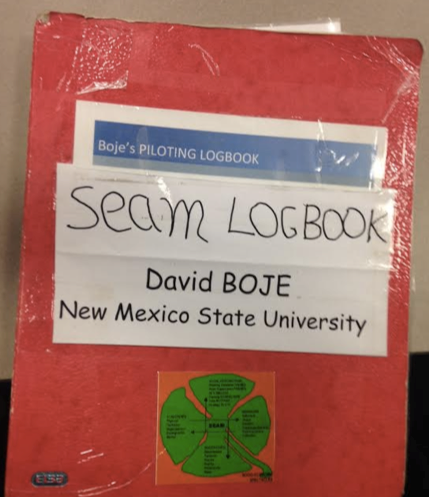
PNAC TOOL
This is the last and the first tool you will use. The PNAC is your contract between you and your instructor. PNAC stands for "Periodically Negotiated Activity Contract". SEAM uses the PNAC tool to get management and employees to negotiate roles, tasks, and rewards. Contracting is the basis of a more democratic Work Organization where employees share in rewards for the innovations and successes they bring about.
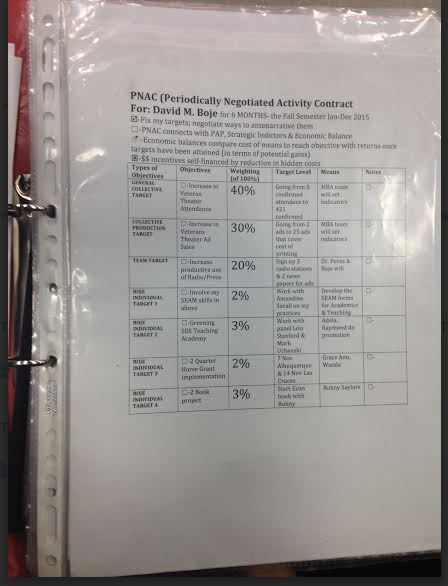
Above is Boje's PNAC. Please download the PNAC TOOL form and begin to develop your proposed contract for this course.
PILOTING LOGBOOK WEEKLY UPDATE FORM
This form is used weekly and turned in at each class meeting. At the beginning of each week decide what you are working on. At your client interviews, take verbatim notes, and use this form to record the dates of your interviews with clients. Turn in an update, once each week during the course. Submit it with your weekly Canvas homework.

Please download the PILOTING LOGBOOK WEEKLY UPDATE, a WORD file you can begin to develop for your weekly updates. Save a copy of what you turn in.
HOW TO KEEP PILOT LOGBOOK ORGANIZED?

Put in GREENING the Business Sustainability Metrics. Make a special page for Greening Metrics in your Strategic Piloting Logbook.
This next tool must be taught to client during 1st or 2nd meeting. To teach it you must actually do it yourself in your own life. That means you keep a TIME DIARY, each work day (school, work, classes, etc.) and figure you how to save time (1 and 2) and reinvest time (3, 4, & 5).
TIME MANAGEMENT TOOL
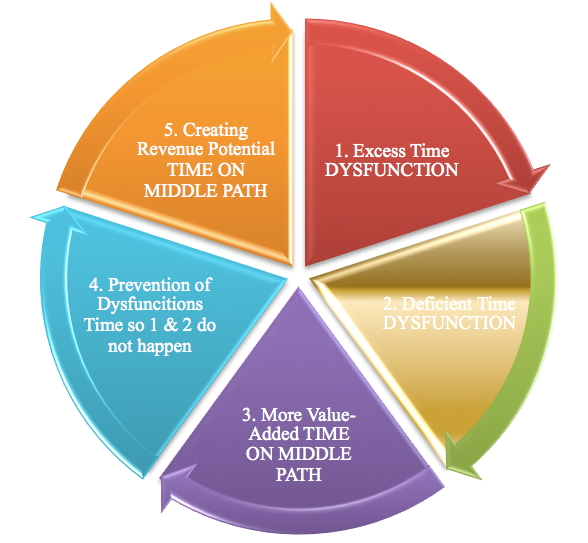
- 1st DYSFUNCTION: (Shift in Function) EXCESS TIME that is definitely not adding value to the business (its sales or services, its strategic outcomes); tasks or functions that need to be abandoned, transferred, DELEGATED, or eliminated. The client’s answers to D-questions (Dispersion & Detaching processes no longer needed) can be included here. This is where you get the time needed to do 3 to 5.
- 2nd DYSFUNCTION: (Regulation of Dysfunction) DEFICIENCY TIME – Time spent correcting mistakes such as rework, due to dysfunctions that could be resolved in production, marketing, cash-to-cash (i.e. time it takes to convert inputs to cash flows), inventory, ordering time, etc.. This includes lack of good habits of action. This is also where by resolving deficiencies in quality and productivity you get more time to do 3 to 5.
- 1st and 2nd Dysfunctions get resolved so that ...
- 3rd is More Value Added Time is available: Savall et al., (2008) calls it ‘Day to Day Management’– Time that adds value to the production of goods and services, to necessary functions. Teach clients to maintain these value-added habits of action.
- 4th is Prevention of Dysfunctions by pro-active use of tools (Time management, logbook of indicators, PAP, I/ESP, PNAC, & Spiral Updraft) and making the strategic and political choices (main directions, rules of the game, etc.) so 1st and 2nd dysfunction do not happen. Distracted owners who forget to prevent 1 (excess dysfunction) and 2 (deficient dysfunction) are spinning their wheels, putting out fires instead of preventing them. This also needs to become a habit of action.
- 5th is Creating Revenue Potential – Time on the Middle Path : This is two things. First, it is tending to the stem-roots of the business (Excess Salary, Overtime, Risks, Non-production, Over-consumption, & Non-creation of Potential Revenue). Second, it is the C-spiral, shaping the future with strategies that enhance revenue potential: main directions, rules of the game, expand the market, build capacity, advertise, market, etc. It is an investment of time in the future that a small business cannot do without , if 1 and 2 and 4 are out of control, or no #3 (value-added) is consistently happening. It is oftentimes the most neglected area, because there is no time left to do it, if 1-4 are out of control. Again, this needs to become a habit of action.
Time Diary
1st DYSFUNCTION: EXCESS TIME ON WRONG STUFF
- How much time do you spend putting out fires?
- How much time do you spend doing things others could be taught to do?
- How much time do you spend doing other people’s jobs that don’t show up?
2nd DYSFUNCTION: DEFICIENT TIME
- How much time do you spend correcting mistakes other make?
- How much time do you spend because materials are not right?
- How much time do you spend in rework?
3rd More Value Added Time
- How much time do you spend that is adding value in the long-term?
- How much time do you spend expanding your market?
- How much time do you spend innovating?
- How much time do you spend implementing strategic moves?
4th PREVENTING DYSFUNCTIONS
- How much time do you spend training so dysfunctions do not happen?
- How much time do you spend creating systems that work well so dysfunctions don’t keep happening again and again?
- How much time do you spend listening to people you work with so you learn together to stop dysfunctions before they happen?
5th CHANGING THE STRATEGIC DECISION TIME
- How much time do you spend changing the direction of this business, so you get results you want to get?
- How much time do you spend changing the rules of the game (procedures, policies)?
- How much time do you spend reploying resources needed to get job done right?
- How much time do you spend developing new technology processes to get it done right every time?
- How much time do you spend developing the kind of flexible, agile management system that stops the bureaucracy, so you getting to success?
- How much time do you spend developing human potential?
- How much time do you spend developing a sustainable business (profit, people, & planet)?
Practice the reducing 1 & 2 in your own life so you have more time for 3, 4, and 5. Then teach it to your client, so you get a new TIME MANAGEMENT that could look like this:
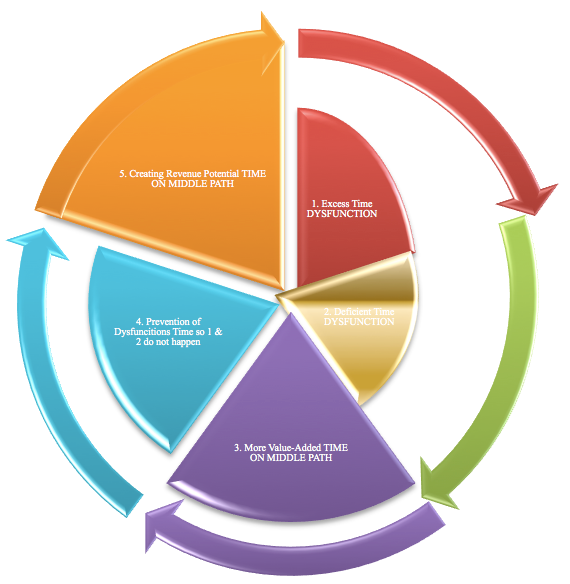
Please download your TIME MANAGEMENT TOOL form
PAP TOOL
PAP is the Priority Action Plan for reducing dysfunctions and expanding value-added potential structures, behaviors, and growing positive stem-roots. It covers the immediate time period of this 16 week semester.
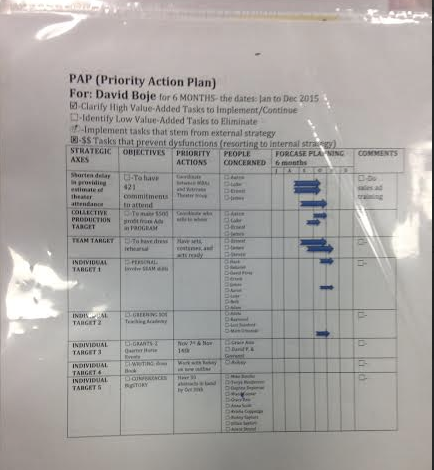
Please download the PAP form so you can begin to set goals and action plans for this semester.
THE Internal/External STRATEGIC PLAN (IESP)
Develop three objectives for a 5-year plan to develop markets, technology, products, human potential, and sustainability. The IESP carries out PAP in the long term, beyond the end of this semester. You need client set up to continue what you have begun.
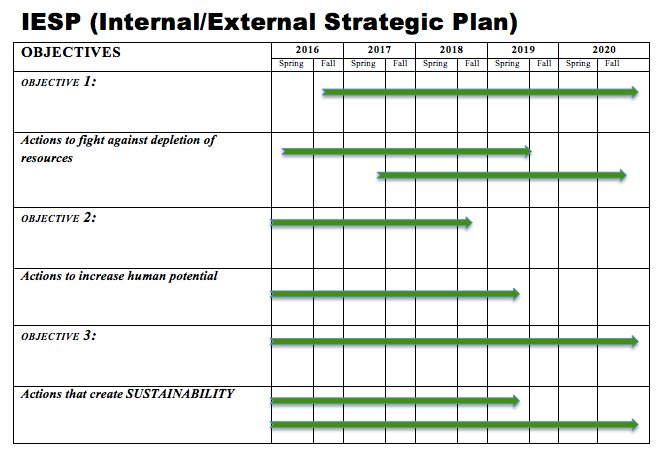
Please have at least one GREEN OBJECTIVE IN IESP.
Please download IESP TOOL form.
As you interview owner, managers, teachnical people, workers, etc. you will draft the Before, Competency Grid, and another after your 3 D-P-I-E interventions, draft the After Competency Grid. These are competencies you and client decide together, that each worker needs, in-order-to move from ways they are perfectly designed to get financial results they have been getting, to the new successful financial results.
COMPETENCY GRID TOOL (Before and After Change Interventions)

Please download WORD version of COMPETENCY GRID TOOL.
You have a form for each of the Six MANAGEMENT TOOLS:
- PNAC TOOL form
- TIME MANAGEMENT TOOL form
- PAP TOOL form
- IESP TOOL form
- COMPETENCY GRID TOOL form
- PILOTING LOGBOOK WEEKLY UPDATE